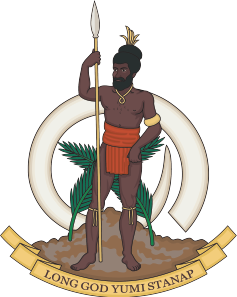Thank you Mr President.
One man's generous gift to the Museum

On Tuesday October 26, the South Pacific WWII Museum received a wonderful gift in memory of one of Santo’s most cherished residents. Allan Power’s estate and family donated his Coolidge collection to the Museum.
It will take some time to clean, document and prepare the items for display. But just how did the Museum become the recipient of such an important collection?
To answer that, we need to go back to February 1931, when Mrs. Calvin C. Coolidge broke a bottle of water that came from a brook on the Coolidge farm in Vermont on the bow of a ship, thereby sending the SS President Coolidge down the slips and into the James River in Virginia.
![]() Beginning her life as a luxury ocean liner, the Coolidge was eventually acquired by the US War Department in 1941 who after a repaint and refit in mid-1942, began using her to transport men and equipment throughout the South Pacific.
Beginning her life as a luxury ocean liner, the Coolidge was eventually acquired by the US War Department in 1941 who after a repaint and refit in mid-1942, began using her to transport men and equipment throughout the South Pacific.
That refit and a conversion enabled the Coolidge to carry around 5000 troops in her new guise as a military troop ship. Many of the ship’s civilian fittings were removed altogether or boarded over to protect them. Additionally, the Coolidge had guns mounted on her and the beautiful black and white hull was repainted a more traditional US Navy grey.
The Coolidge continued troop transport duties throughout the South West Pacific. Her ports of call included Bora Bora, Suva, Auckland, Wellington and Melbourne where in the Spring of 1942, she transported the President of the Philippines, Manuel Quezon to San Francisco.
On October 6 1942, the Coolidge set sail for New Caledonia and the New Hebrides. On board were the 172nd Infantry Combat Team, 43rd Division and a harbour defence unit that was going to protect the new bomber base on Santo that was providing support for the Allied forces at Guadalcanal.
Arriving off the coast of Espiritu Santo on October 26, 1942, the Coolidge proceeded to enter the harbour via the Segond Channel. The constant threat of Japanese submarines around the island resulted in the channel entrances being mined with sea mines assembled on nearby Aore Island. However, the location of the mines was omitted from the Coolidge’s sailing orders due to US navy regulations at the time.
As the Coolidge transited the Segond Channel, she hit a mine that exploded next to the ship’s engine room killing Fireman Robert Read, and seconds later a second mine exploded near her stern.
The ship’s Captain Henry Nelson, was well aware that the ship was lost, so he ran the 22,000 ton troop ship aground in the shallowest water he could reach before the ship began to list and eventually sink.
The 5,340 troops and crew abandoned ship. Many of the men on board simply walked ashore in a very calm manner, believing the ship was safely grounded in shallow waters.
However, the Coolidge didn’t end up where Captain Nelson intended and was stuck fast on a coral reef on the edge of the channel.
Not long after she ran aground, the Coolidge listed heavily, rolled onto her side and slipped down into the shipping channel.
There were just two casualties of the sinking of the Coolidge. Fireman Robert Reid, and Captain Elwood J Euart, the namesake of the association behind the South Pacific WWII Museum.
Captain Euart of the 103rd Field Artillery Regiment, was one of the 5,340 who made it ashore after the Coolidge ran aground.
However, Euart heard that there were men still trapped below decks. He immediately returned to the ship, entered via sea door and was lowered on a rope down inside the ship. The men were found and successfully rescued thanks to the brave efforts of Captain Euart. However, the sheer effort of pulling the men up and out of the ship on a rope had left him exhausted. By the time it was his turn to get out, he didn’t have the strength in his arms to pull himself out and went down with the ship.
There the ship lay for less than 30 years. Then along came a young Australian by the name of Allan Power.
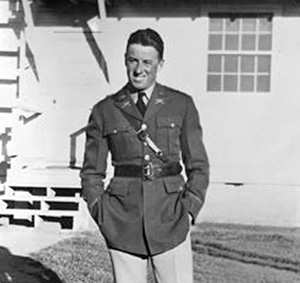
Captain Elwood J Euart, US Army 103rd Field Artillery Regiment
The stuff of legends
Allan Power remains one of the world’s most respected divers, and a true legend within the SCUBA community. More than that, Allan was also unique and cherished identity on Espiritu Santo.
Born in Sydney, Australia in 1933, Allan began his working life as a qualified pastry chef in 1953, before working in a foam rubber factory for 15 years.
Purchasing his first underwater camera in 1956, his passion with the undersea world soon blossomed spending his holidays in the early 60s on Heron Island on the Great Barrier Reef. It wasn’t long before Allan’s eye for the exquisite beauty of the reef saw him win the much coveted Levanto prize for underwater photography, and the beginnings of a remarkable career photographing the world’s oceans.
His treasured book The Great Barrier Reef published in 1977, opened the eyes of the world to the incredible beauty of the reef.
In December 1969 Allan travelled to Santo on board the salvage ship Pacific Seal with Barry May to photograph the salvage of the propellers from the SS President Coolidge.
Back then, the ship was just another rusting WWII hulk sitting on the seafloor. However her four ton brass propellers were worth a great deal, purely for their scrap value alone. In fact at one point, there was talk of refloating the entire ship and towing it away to be sold as scrap – talk that prompted Allan to recover many items off the seafloor, to at least preserve something before it was lost to the salvagers forever.
Luckily for Espiritu Santo, the entire ship wasn’t raised and Allan soon became heavily involved with the salvage of the ship’s massive propellers and one could assume, this was where his passion for the great lady began.
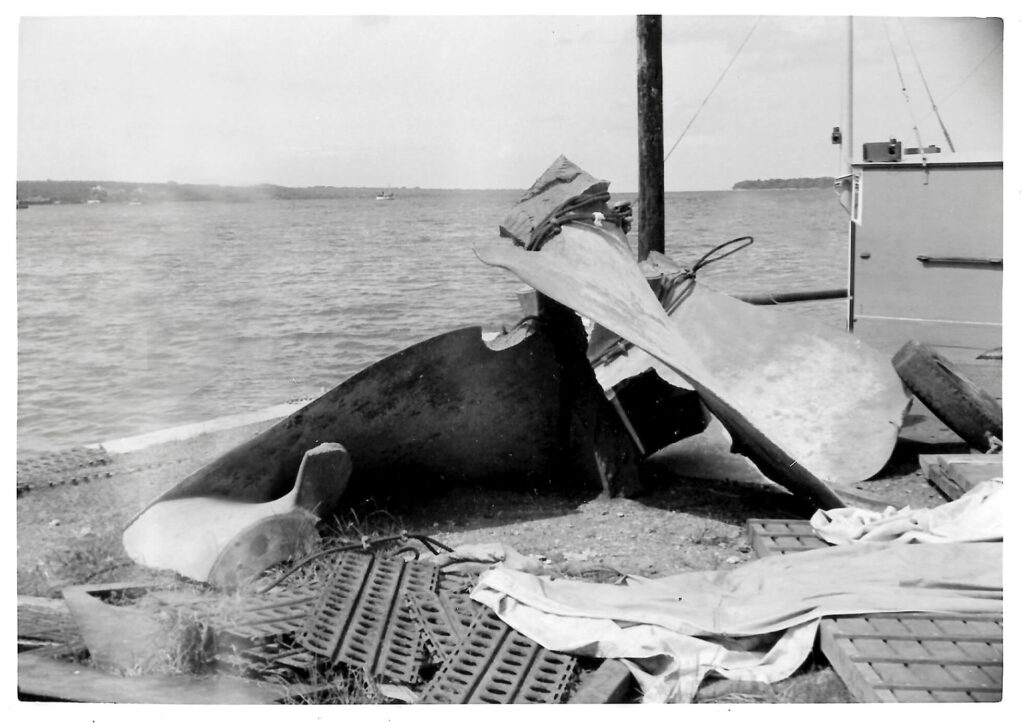
Part of one of the three propellers on Santo wharf after the recovery.
Photo Thierry Colardeau.
In 1978 Allan was offered the position of diving director on Bokissa Island Resort. It wasn’t long before he returned to Santo following the Coconut Rebellion, and in 1981 he established Allan Power Dive Tours.
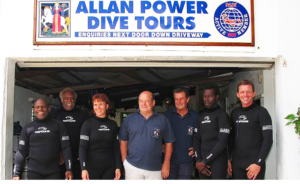
In fact, it is widely recognised that Allan really kick started tourism on Espiritu Santo and was therefore a founding father to economic growth of the island, prompting the locals on Santo to always call him “Uncle”.
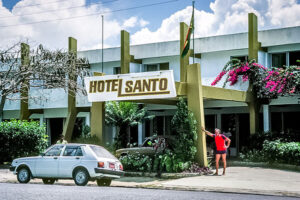
So much so that on November 8, 2011, Allan was inducted into the International SCUBA Diving Hall of Fame in the Cayman Islands. This prestigious award recognised his enormous contribution to the diving industry in general and his incredible work and achievements on the Coolidge. After flying all the way to to the Cayman Islands in person to accept the award, Alan stayed only a few days then came straight back to the island that he loved.
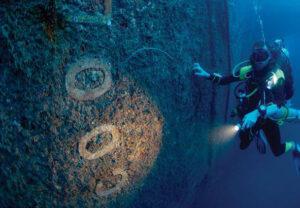
That find resulted in a massive operation led by a team of experts from the US Military in Hawaii. They brought in tonnes of gear on heavy-lift transport jets which resulted in the successful recovery and repatriation of Captain Euart’s remains back to his home town in Pawtucket, Rhode Island, USA.
When Allan first contacted Captain Euart’s relatives they spoke of the monument built by Captain Euart’s men and sent a photo of it to him. Allan then went and found the now forgotten monument in the bushes, not far from the wreck site, cleared around it, repainted it and looked after it to what it is today. That’s the kind of man Allan always was – caring, considerate and compassionate.n
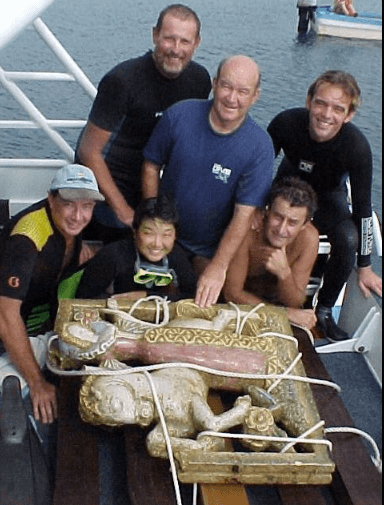
The crew of divers who, with Allan, successfully recovered ‘The Lady’ after she fell off her wall, repaired her, and safely put her back on the Coolidge.
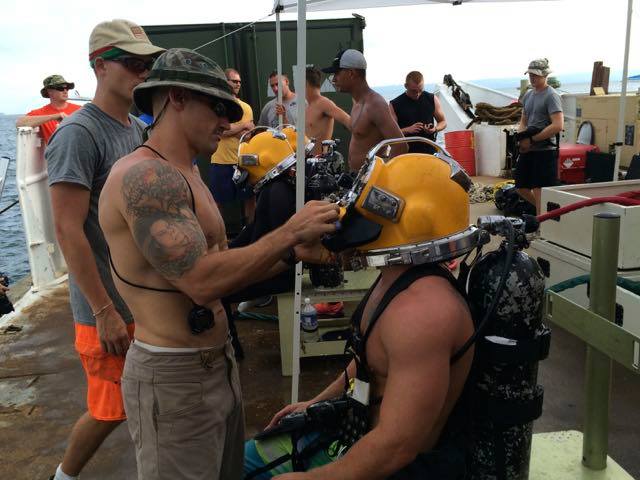
US divers prepare to go down to the Coolidge to retrieve Captain Euart’s remains from deep within the SS President Coolidge. Time was against the recovery as a cyclone was bearing down on Vanuatu. The diver’s just got out in time.
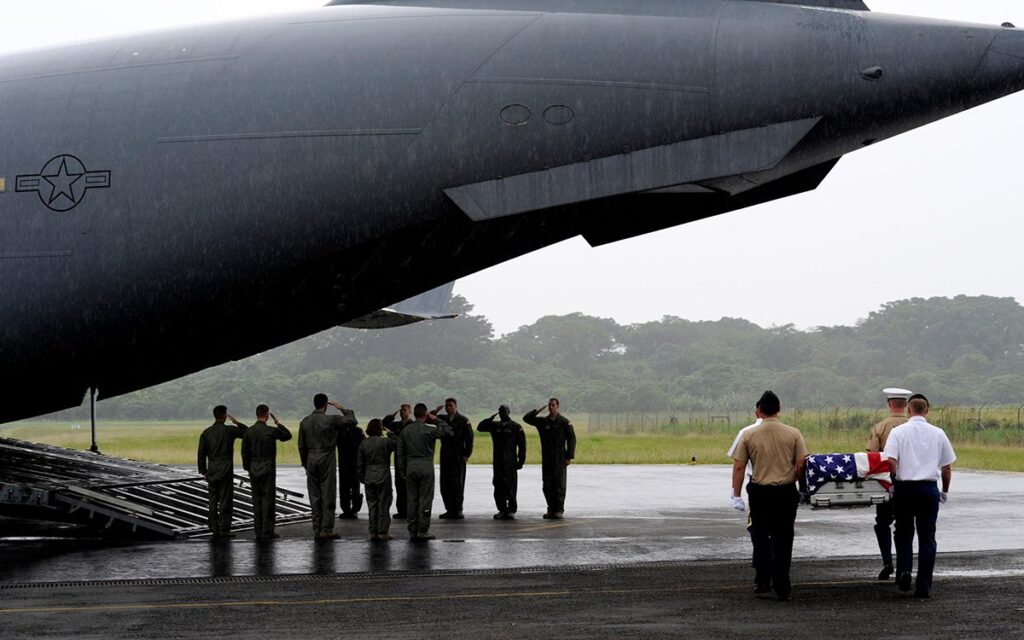
A United States Air Force C-17 transport jet sits at Santo International Airport. An Honour Guard stands either side of the ramp as Captain Euart’s remains are walked slowly over the the aircraft for his final trip home to the USA.

Euart’s nieces and nephews (l-r) Sister of Mercy Sharon Euart, Woody and John F. Euart and Linda Kelleher pose with the flag that was draped over their uncle’s coffin at St. Francis Cemetery, Pawtucket, Rhode Island, USA.
Allan passed away suddenly in December 2018. He had made over 15,000 dives on the Coolidge and had taken over 20,000 divers to the Lady alone – a remarkable achievement for someone who was still diving into his 85th year.
Prior to his passing he said to Museum Chairman, Bradley Wood, that one day he would like to donate his collection of artefacts that he had rescued from the Coolidge to the Museum. Late in October, that’s exactly what happened. Such a shame, Allan couldn’t have been there to not only hand them over to the Museum, but tell us the fascinating stories behind every piece. here’s just some of what was donated to the Museum.
We will always fondly remember Allan and all he did to care for ‘his’ Lady, her ship and the people of Vanuatu.
We would like to thank Allan’s business partner Tony Lewis, Lionel Jimmy, Allan’s sister Sandra Field and Sandra’s daughter Amanda and son Bartley (executors of Allan’s estate), most sincerely for honouring Allan’s wish to donate his remarkable collection to us.
Tankyu Tumas.


